A Preview of Calculus
For the following exercises (1-3), points [latex]P(1,2)[/latex] and [latex]Q(x,y)[/latex] are on the graph of the function [latex]f(x)=x^2+1[/latex].
- Complete the following table with the appropriate values: [latex]y[/latex]-coordinate of Q, the point [latex]Q(x,y),[/latex] and the slope of the secant line passing through points P and Q. Round your answer to eight significant digits.
[latex]x[/latex] [latex]y[/latex] [latex]Q(x,y)[/latex] [latex]m_{\sec}[/latex] [latex]1.1[/latex] a. e. i. [latex]1.01[/latex] b. f. j. [latex]1.001[/latex] c. g. k. [latex]1.0001[/latex] d. h. l. - Use the values in the right column of the table in the preceding exercise to guess the value of the slope of the line tangent to [latex]f[/latex] at [latex]x=1[/latex].
- Use the value in the preceding exercise to find the equation of the tangent line at point [latex]P[/latex]. Graph [latex]f(x)[/latex] and the tangent line.
For the following exercises (4-6), points [latex]P(1,1)[/latex] and [latex]Q(x,y)[/latex] are on the graph of the function [latex]f(x)=x^3[/latex].
- Complete the following table with the appropriate values: [latex]y[/latex]-coordinate of [latex]Q[/latex], the point [latex]Q(x,y)[/latex], and the slope of the secant line passing through points [latex]P[/latex] and [latex]Q[/latex]. Round your answer to eight significant digits.
[latex]x[/latex] [latex]y[/latex] [latex]Q(x,y)[/latex] [latex]m_{\sec}[/latex] [latex]1.1[/latex] a. e. i. [latex]1.01[/latex] b. f. j. [latex]1.001[/latex] c. g. k. [latex]1.0001[/latex] d. h. l. - Use the values in the right column of the table in the preceding exercise to guess the value of the slope of the tangent line to [latex]f[/latex] at [latex]x=1[/latex].
- Use the value in the preceding exercise to find the equation of the tangent line at point [latex]P[/latex]. Graph [latex]f(x)[/latex] and the tangent line.
For the following exercises (7-9), points [latex]P(4,2)[/latex] and [latex]Q(x,y)[/latex] are on the graph of the function [latex]f(x)=\sqrt{x}[/latex].
- Complete the following table with the appropriate values: [latex]y[/latex]-coordinate of [latex]Q[/latex], the point [latex]Q(x,y)[/latex], and the slope of the secant line passing through points [latex]P[/latex] and [latex]Q[/latex]. Round your answer to eight significant digits.
[latex]x[/latex] [latex]y[/latex] [latex]Q(x,y)[/latex] [latex]m_{\sec}[/latex] [latex]4.1[/latex] a. e. i. [latex]4.01[/latex] b. f. j. [latex]4.001[/latex] c. g. k. [latex]4.0001[/latex] d. h. l. - Use the values in the right column of the table in the preceding exercise to guess the value of the slope of the tangent line to [latex]f[/latex] at [latex]x=4[/latex].
- Use the value in the preceding exercise to find the equation of the tangent line at point [latex]P[/latex].
For the following exercises (10-12), points [latex]P(1.5,0)[/latex] and [latex]Q(\phi ,y)[/latex] are on the graph of the function [latex]f(\phi )= \cos (\pi \phi )[/latex].
- Complete the following table with the appropriate values: [latex]y[/latex]-coordinate of [latex]Q[/latex], the point [latex]Q(x,y)[/latex], and the slope of the secant line passing through points [latex]P[/latex] and [latex]Q[/latex]. Round your answer to eight significant digits.
[latex]x[/latex] [latex]y[/latex] [latex]Q(\phi ,y)[/latex] [latex]m_{\sec}[/latex] [latex]1.4[/latex] a. e. i. [latex]1.49[/latex] b. f. j. [latex]1.499[/latex] c. g. k. [latex]1.4999[/latex] d. h. l. - Use the values in the right column of the table in the preceding exercise to guess the value of the slope of the tangent line to [latex]f[/latex] at [latex]x=4[/latex].
- Use the value in the preceding exercise to find the equation of the tangent line at point [latex]P[/latex].
For the following exercises (13-15), points [latex]P(-1,-1)[/latex] and [latex]Q(x,y)[/latex] are on the graph of the function [latex]f(x)=\dfrac{1}{x}[/latex].
- Complete the following table with the appropriate values: [latex]y[/latex]-coordinate of [latex]Q[/latex], the point [latex]Q(x,y)[/latex], and the slope of the secant line passing through points [latex]P[/latex] and [latex]Q[/latex]. Round your answer to eight significant digits.
[latex]x[/latex] [latex]y[/latex] [latex]Q(x,y)[/latex] [latex]m_{\sec}[/latex] [latex]-1.05[/latex] a. e. i. [latex]-1.01[/latex] b. f. j. −[latex]-1.005[/latex] c. g. k. [latex]-1.001[/latex] d. h. l. - Use the values in the right column of the table in the preceding exercise to guess the value of the slope of the line tangent to [latex]f[/latex] at [latex]x=-1[/latex].
- Use the value in the preceding exercise to find the equation of the tangent line at point [latex]P[/latex].
For the following exercises (16-17), the position function of a ball dropped from the top of a 200-meter tall building is given by [latex]s(t)=200-4.9t^2[/latex], where position [latex]s[/latex] is measured in meters and time [latex]t[/latex] is measured in seconds. Round your answer to eight significant digits.
- Compute the average velocity of the ball over the given time intervals.
- [latex][4.99,5][/latex]
- [latex][5,5.01][/latex]
- [latex][4.999,5][/latex]
- [latex][5,5.001][/latex]
- Use the preceding exercise to guess the instantaneous velocity of the ball at [latex]t=5[/latex] sec.
For the following exercises (18-19), consider a stone tossed into the air from ground level with an initial velocity of 15 m/sec. Its height in meters at time [latex]t[/latex] seconds is [latex]h(t)=15t-4.9t^2[/latex].
- Compute the average velocity of the stone over the given time intervals.
- [latex][1,1.05][/latex]
- [latex][1,1.01][/latex]
- [latex][1,1.005][/latex]
- [latex][1,1.001][/latex]
- Use the preceding exercise to guess the instantaneous velocity of the stone at [latex]t=1[/latex] sec.
For the following exercises (20-21), consider a rocket shot into the air that then returns to Earth. The height of the rocket in meters is given by [latex]h(t)=600+78.4t-4.9t^2[/latex], where [latex]t[/latex] is measured in seconds.
- Compute the average velocity of the rocket over the given time intervals.
- [latex][9,9.01][/latex]
- [latex][8.99,9][/latex]
- [latex][9,9.001][/latex]
- [latex][8.999,9][/latex]
- Use the preceding exercise to guess the instantaneous velocity of the rocket at [latex]t=9[/latex] sec.
For the following exercises (22-23), consider an athlete running a 40-m dash. The position of the athlete is given by [latex]d(t)=\dfrac{t^3}{6}+4t[/latex], where [latex]d[/latex] is the position in meters and [latex]t[/latex] is the time elapsed, measured in seconds.
- Compute the average velocity of the runner over the given time intervals.
- [latex][1.95,2.05][/latex]
- [latex][1.995,2.005][/latex]
- [latex][1.9995,2.0005][/latex]
- [latex][2,2.00001][/latex]
- Use the preceding exercise to guess the instantaneous velocity of the runner at [latex]t=2[/latex] sec.
For the following exercises (24-25), consider the function [latex]f(x)=|x|[/latex].
- Sketch the graph of [latex]f[/latex] over the interval [latex][-1,2][/latex] and shade the region above the [latex]x[/latex]-axis.
- Use the preceding exercise to find the exact value of the area between the [latex]x[/latex]-axis and the graph of [latex]f[/latex] over the interval [latex][-1,2][/latex] using rectangles. For the rectangles, use the square units, and approximate both above and below the lines. Use geometry to find the exact answer.
For the following exercises (26-27), consider the function [latex]f(x)=\sqrt{1-x^2}[/latex]. (Hint: This is the upper half of a circle of radius [latex]1[/latex] positioned at [latex](0,0)[/latex].)
- Sketch the graph of [latex]f[/latex] over the interval [latex][-1,1][/latex].
- Use the preceding exercise to find the exact area between the [latex]x[/latex]-axis and the graph of [latex]f[/latex] over the interval [latex][-1,1][/latex] using rectangles. For the rectangles, use squares [/latex]0.4[/latex] by [latex]0.4[/latex] units, and approximate both above and below the lines. Use geometry to find the exact answer.
For the following exercises (28-29), consider the function [latex]f(x)=−x^2+1[/latex].
- Sketch the graph of [latex]f[/latex] over the interval [latex][-1,1][/latex].
- Approximate the area of the region between the [latex]x[/latex]-axis and the graph of [latex]f[/latex] over the interval [latex][-1,1][/latex].
Introduction to the limit of a function
In the following exercises (1-3), set up a table of values to find the indicated limit. Round to eight digits.
- [latex]\underset{x\to 1}{\lim}(1-2x)[/latex]
[latex]x[/latex] [latex]1-2x[/latex] [latex]x[/latex] [latex]1-2x[/latex] 0.9 a. [latex]1.1[/latex] e. 0.99 b. [latex]1.01[/latex] f. 0.999 c. [latex]1.001[/latex] g. 0.9999 d. [latex]1.0001[/latex] h. - [latex]\underset{z\to 0}{\lim}\dfrac{z-1}{z^2(z+3)}[/latex]
[latex]z[/latex] [latex]\frac{z-1}{z^2(z+3)}[/latex] [latex]z[/latex] [latex]\frac{z-1}{z^2(z+3)}[/latex] [latex]−0.1[/latex] a. [latex]0.1[/latex] e. [latex]−0.01[/latex] b. [latex]0.01[/latex] f. [latex]−0.001[/latex] c. [latex]0.001[/latex] g. [latex]−0.0001[/latex] d. [latex]0.0001[/latex] h. - [latex]\underset{x\to 2^-}{\lim}\dfrac{1-\frac{2}{x}}{x^2-4}[/latex]
[latex]x[/latex] [latex]\frac{1-\frac{2}{x}}{x^2-4}[/latex] [latex]x[/latex] [latex]\frac{1-\frac{2}{x}}{x^2-4}[/latex] [latex]1.9[/latex] a. [latex]2.1[/latex] e. [latex]1.99[/latex] b. [latex]2.01[/latex] f. [latex]1.999[/latex] c. [latex]2.001[/latex] g. [latex]1.9999[/latex] d. [latex]2.0001[/latex] h.
In the following exercise, set up a table of values and round to eight significant digits. Based on the table of values, make a guess about what the limit is. Then, use a calculator to graph the function and determine the limit. Was the conjecture correct? If not, why does the method of tables fail?
- [latex]\underset{\alpha \to 0^+}{\lim}\frac{1}{\alpha} \cos \left(\frac{\pi }{\alpha }\right)[/latex]
[latex]a[/latex] [latex]\frac{1}{\alpha } \cos (\frac{\pi }{\alpha })[/latex] [latex]0.1[/latex] a. [latex]0.01[/latex] b. [latex]0.001[/latex] c. [latex]0.0001[/latex] d.
In the following exercises (5-6), consider the graph of the function [latex]y=f(x)[/latex] shown here. Which of the statements about [latex]y=f(x)[/latex] are true and which are false? Explain why a statement is false.
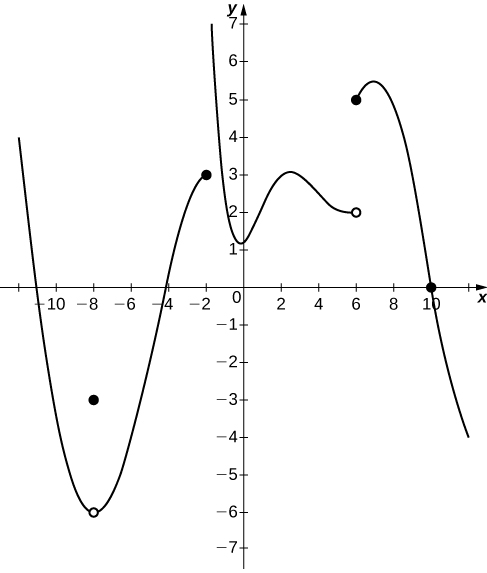
- [latex]\underset{x\to -2^+}{\lim}f(x)=3[/latex]
- [latex]\underset{x\to 6}{\lim}f(x)=5[/latex]
In the following exercises (7-9), use the following graph of the function [latex]y=f(x)[/latex] to find the values, if possible. Estimate when necessary.
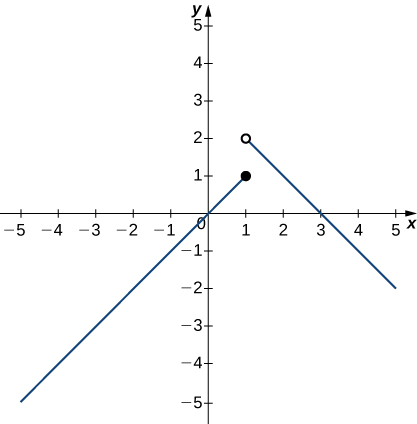
- [latex]\underset{x\to 1^-}{\lim}f(x)[/latex]
- [latex]\underset{x\to 1^+}{\lim}f(x)[/latex]
- [latex]\underset{x\to 1}{\lim}f(x)[/latex]
In the following exercises 10-11), use the graph of the function [latex]y=f(x)[/latex] shown here to find the values, if possible. Estimate when necessary.
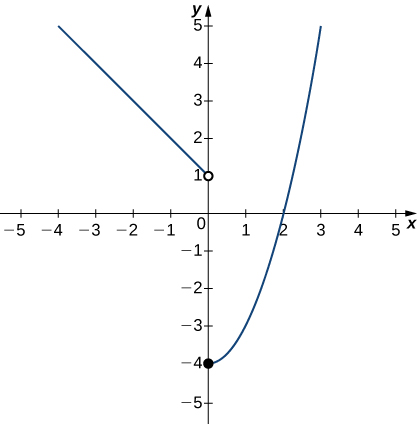
- [latex]\underset{x\to 0^-}{\lim}f(x)[/latex]
- [latex]\underset{x\to 0}{\lim}f(x)[/latex]
In the following exercises (12-17), use the graph of the function [latex]y=f(x)[/latex] shown here to find the values, if possible. Estimate when necessary.
![A graph of a piecewise function with three segments, all linear. The first exists for x < -2, has a slope of 1, and ends at the open circle at (-2, 0). The second exists over the interval [-2, 2], has a slope of -1, goes through the origin, and has closed circles at its endpoints (-2, 2) and (2,-2). The third exists for x>2, has a slope of 1, and begins at the open circle (2,2).](https://s3-us-west-2.amazonaws.com/courses-images/wp-content/uploads/sites/2332/2018/01/11202943/CNX_Calc_Figure_02_02_204.jpg)
- [latex]\underset{x\to -2^-}{\lim}f(x)[/latex]
- [latex]\underset{x\to -2^+}{\lim}f(x)[/latex]
- [latex]\underset{x\to -2}{\lim}f(x)[/latex]
- [latex]\underset{x\to 2^-}{\lim}f(x)[/latex]
- [latex]\underset{x\to 2^+}{\lim}f(x)[/latex]
- [latex]\underset{x\to 2}{\lim}f(x)[/latex]
In the following exercises (18-20), use the graph of the function [latex]y=g(x)[/latex] shown here to find the values, if possible. Estimate when necessary.
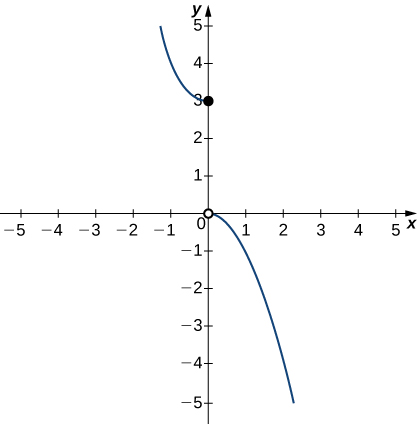
- [latex]\underset{x\to 0^-}{\lim}g(x)[/latex]
- [latex]\underset{x\to 0^+}{\lim}g(x)[/latex]
- [latex]\underset{x\to 0}{\lim}g(x)[/latex]
In the following exercises (21-23), use the graph of the function [latex]y=h(x)[/latex] shown here to find the values, if possible. Estimate when necessary.
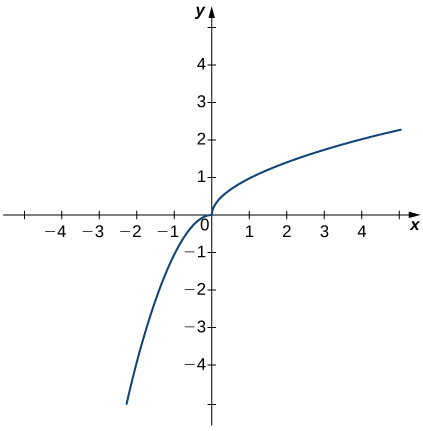
- [latex]\underset{x\to 0^-}{\lim}h(x)[/latex]
- [latex]\underset{x\to 0^+}{\lim}h(x)[/latex]
- [latex]\underset{x\to 0}{\lim}h(x)[/latex]
In the following exercises (24-25), sketch the graph of a function with the given properties.
- [latex]\underset{x\to -\infty }{\lim}f(x)=0, \, \underset{x\to -1^-}{\lim}f(x)=−\infty[/latex], [latex]\underset{x\to -1^+}{\lim}f(x)=\infty, \, \underset{x\to 0}{\lim}f(x)=f(0), \, f(0)=1, \, \underset{x\to \infty }{\lim}f(x)=−\infty[/latex]
- [latex]\underset{x\to -\infty }{\lim}f(x)=2, \, \underset{x\to -2}{\lim}f(x)=−\infty[/latex],[latex]\underset{x\to \infty }{\lim}f(x)=2, \, f(0)=0[/latex]